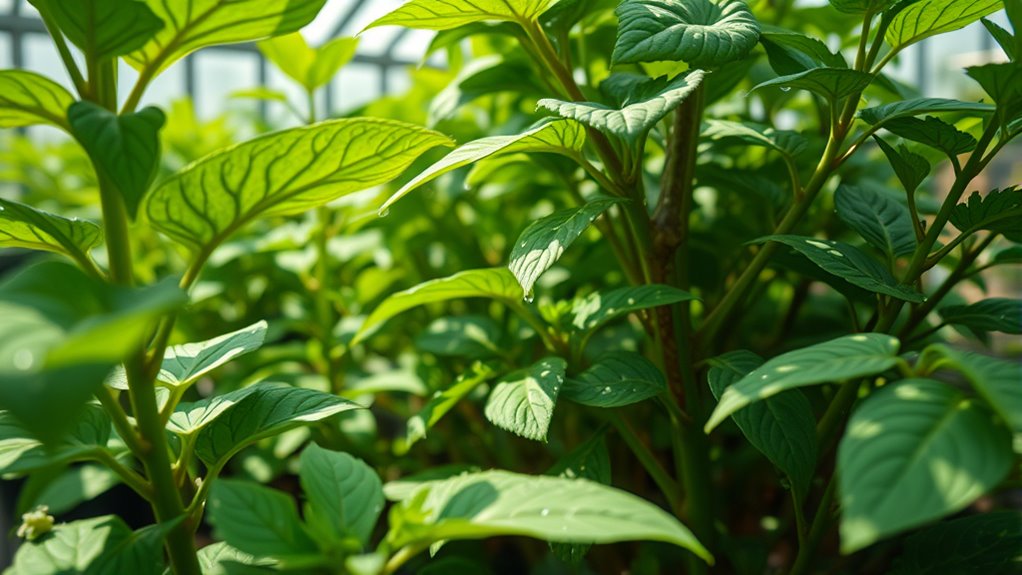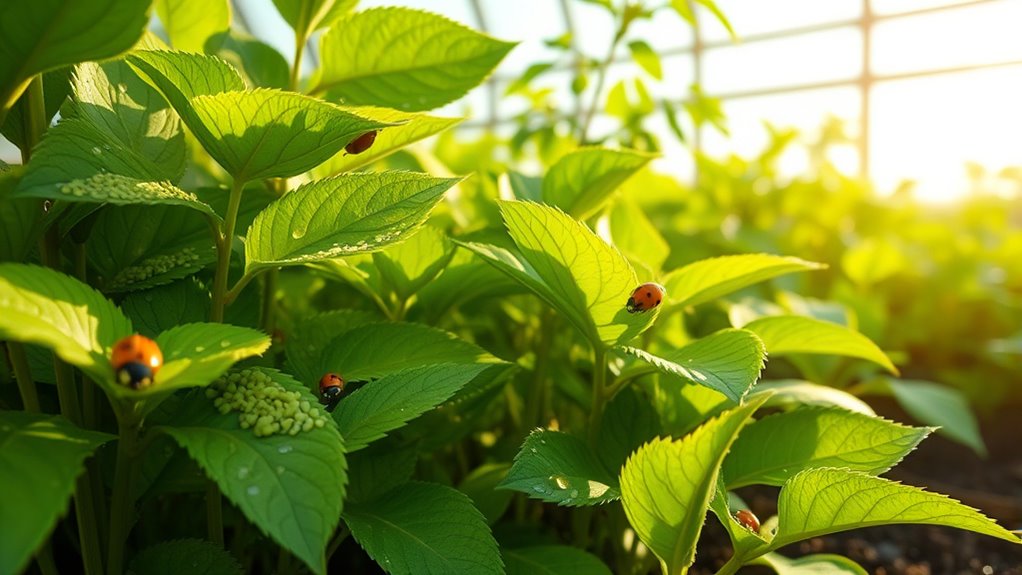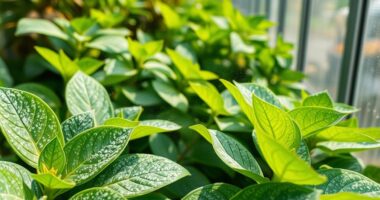To naturally eliminate aphids from your greenhouse, encourage beneficial insects like ladybugs, lacewings, and parasitic wasps that prey on aphids. Plant companion plants such as marigolds or dill to attract these helpful bugs, and provide shelter like insect hotels. Regularly check your plants for signs of infestations, and use organic pesticides like neem oil or insecticidal soap if needed. Maintaining good airflow and healthy plants further reduces aphid problems—learn more to master a balanced, eco-friendly approach.
Key Takeaways
- Introduce beneficial insects like ladybugs, lacewings, and parasitic wasps to naturally prey on aphids.
- Use organic pesticides such as neem oil, insecticidal soap, or pyrethrin, applying thoroughly and repeatedly if needed.
- Regularly monitor plants for aphid signs like honeydew, leaf curling, or clusters to catch infestations early.
- Maintain good airflow, avoid over-fertilizing with nitrogen, and keep plants healthy to reduce aphid attraction.
- Combine biological controls with organic pesticides in an integrated approach for effective, eco-friendly aphid management.

If aphids have invaded your greenhouse, acting quickly with natural methods can help protect your plants without resorting to chemicals. The key is to use strategies that target these pests effectively while preserving the health of your plants and the environment. One of the most beneficial approaches involves encouraging beneficial insects, like ladybugs, lacewings, and parasitic wasps, to take up residence in your greenhouse. These insects are natural predators of aphids and can considerably reduce their populations without the need for synthetic pesticides. You can attract beneficial insects by planting companion plants such as marigolds, dill, or fennel, which serve as food sources and habitat for these helpful bugs. Providing shelter, like insect hotels or simple bundling of straw and twigs, also encourages beneficial insects to settle in and hunt aphids naturally.
Another effective method involves using organic pesticides that are safe for both your plants and your environment. Products containing neem oil, insecticidal soaps, or pyrethrin are excellent choices for controlling aphids without harmful chemicals. When applying organic pesticides, be sure to thoroughly cover the undersides of leaves, where aphids often hide, and repeat treatments as necessary. Organic pesticides work by disrupting the aphids’ feeding or reproductive abilities, helping you keep their numbers in check. Always follow the instructions carefully to avoid harming beneficial insects that are working to control the pests naturally.
Use neem oil, insecticidal soaps, or pyrethrin for safe, effective aphid control.
Regular monitoring is vital when managing aphids in your greenhouse. Check your plants daily for signs of infestation, such as sticky honeydew, curled or yellowing leaves, and visible clusters of pests. Early detection allows you to take swift action, combining biological controls with organic pesticides to prevent the aphid population from spiraling out of control. To further discourage aphids, maintain good airflow and avoid over-fertilizing with nitrogen-rich nutrients, which can promote tender new growth that aphids love.
Creating an environment that favors beneficial insects while applying organic pesticides when needed provides a balanced, sustainable approach to controlling aphids. This integrated pest management strategy minimizes chemical use and promotes a healthy, resilient greenhouse ecosystem. By acting quickly and combining these natural methods, you’ll protect your plants effectively and enjoy a thriving, pest-free greenhouse environment.
Frequently Asked Questions
Are Aphids Harmful to Specific Greenhouse Plants More Than Others?
Aphids can be more harmful to certain greenhouse plants due to their plant-specific vulnerabilities and aphid resistance levels. You’ll find delicate plants like lettuce and herbs more susceptible, as they often lack strong defenses. Some plants develop natural resistance, making them less vulnerable. To protect your entire greenhouse, monitor plant-specific vulnerabilities regularly, and implement natural pest control methods tailored to each plant’s resistance levels.
Can Natural Predators Completely Eliminate Aphids in a Greenhouse?
Natural predators can substantially reduce aphid populations, but they might not completely eliminate them. Beneficial insects like ladybugs and lacewings are great for biological control, helping keep aphids in check. However, for full eradication, you often need to combine biological control with other natural methods, like neem oil or introducing more beneficial insects. Consistent monitoring and integrated pest management give you the best chance of controlling aphids naturally.
How Often Should I Inspect My Greenhouse for Aphids?
You should inspect your greenhouse for aphids at least once a week to catch infestations early. Regular pest monitoring helps you identify aphids before they spread or cause significant damage. During inspections, look closely at new growth and undersides of leaves. If you notice any pests or signs of infestation, increase your inspection frequency to prevent problems from escalating. Consistent monitoring is key to maintaining a healthy, aphid-free greenhouse environment.
What Environmental Conditions Favor Aphid Infestations?
Think of a lush, crowded garden where aphids thrive like pests in a fairy tale. Warm temperatures and high humidity levels create the perfect environment for them to flourish. When plant density is too high, airflow decreases, making it easier for aphids to settle and multiply. To keep them at bay, maintain ideal humidity, guarantee proper spacing, and promote airflow to disrupt their cozy conditions, preventing infestations from taking hold.
Are There Any Non-Chemical Methods to Prevent Aphids?
Yes, you can prevent aphids naturally by using companion planting and biological control. Plant garlic, chives, or marigolds nearby to repel aphids, creating a natural barrier. Release beneficial insects like ladybugs or lacewings into your greenhouse to prey on aphids, keeping their population in check. These methods work synergistically, reducing the need for chemical treatments and maintaining a healthy, pest-free environment.
Conclusion
Now that you’ve learned simple, sustainable strategies to squash aphids, your greenhouse will flourish with freedom from pests. By blending bold biological battles, beneficial bugs, and botanical barriers, you can safeguard your garden’s growth naturally. Embrace these eco-friendly efforts, and watch your plants thrive with vitality and vigor. With patience and persistence, you’ll protect your paradise, preventing pests from pestering your plants, and ensuring your green oasis remains lush, lively, and pest-free.








